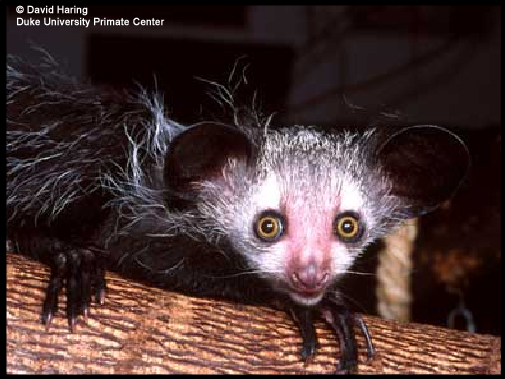The Aye-aye lemur on Nosy Mangabe, Madagascar
In Search of the Aye-aye
Rhett Butler
April 12, 2005
 The aye-aye (Daubentonia madagascariensis). Photo copyright David Haring of the Duke University Primate Center
The aye-aye (Daubentonia madagascariensis). Photo copyright David Haring of the Duke University Primate Center |
Among these lemurs is one of the planet's strangest beasts, the aye-aye. This nocturnal and reclusive lemur looks like it has been assembled from a variety of animals. The aye-aye resembles a large house cat but with the face of a ferret or weasel, bat-like ears capable of rotating independently, teeth that grow constantly like those of a rodent, piercing green eyes, and black hands featuring a bony middle finger reminiscent of a dead twig. The aye-aye uses this finger for locating insect larvae that lurk deep inside tree bark, seeds, and fruit. As it climbs along a tree branch, the aye-aye taps the bark while listening for cavities in the wood. When it hears something potentially appetizing beneath the surface, the aye-aye gnaws away at the wood in search of its prize. Studies suggest that the aye-aye is capable of sensing insect movement at a depth of 12 feet.
The aye-aye's biology is so strange that scientists did not know what to make of the animal when it was described in 1782. Scientists first classified the aye-aye as rodent before realizing that it was just a really peculiar lemur that deserved its own family, Daubentoniidae. In the past, there was a second, larger species of aye-aye. But this species, like more than dozen other species of large lemurs, went extinct after the arrival of humans in Madagascar less than 2000 years ago.
Today, like many of Madagascar's species, the aye-aye is at high risk of going extinct. Habitat loss, combined with persecution by locals as an omen of bad luck (see box) has decimated aye-aye populations across Madagascar. In an effort to stave off its demise, in 1966, six animals were moved to Nosy Mangabe Special Reserve, an island lying about 2 km off the coast of Maroantsetra in northeastern Madagascar in the Bay of Antongil. The ecologists hoped to establish a breeding population of aye-ayes before the species disappeared from the mainland. It has since been found that aye-aye have a wider distribution than initially believed.
Why the aye-aye is a target Madagascar is a land filled with superstition, magic and taboos -- known as fady -- which vary from place to place. A widely held belief on the island is that the aye-aye is a magical beast whose mere presence spells death for a member of the community. Whenever an aye-aye is found it is immediately killed; a tradition when coupled with habitat destruction has left aye-aye populations in a precarious state. Only time will tell whether this practice can be broken and the aye-aye can continue to persist in Madagascar. |
This was not my first visit to this island nor my first attempt to see the aye-aye. During my 1997 trip, I spotted a pair of aye-aye along the beach of Nosy Mangabe as well as enjoying a rare sighting of a mother with baby along a road outside Andasibe park -- we nearly ran over them as we motored back to our lodge on a cold August night. Both sightings proved to be remarkable experiences.
NOSY MANGABE CONTINUED...
page 1 | page 2 | page 3
Nosy Mangabe | Masoala

